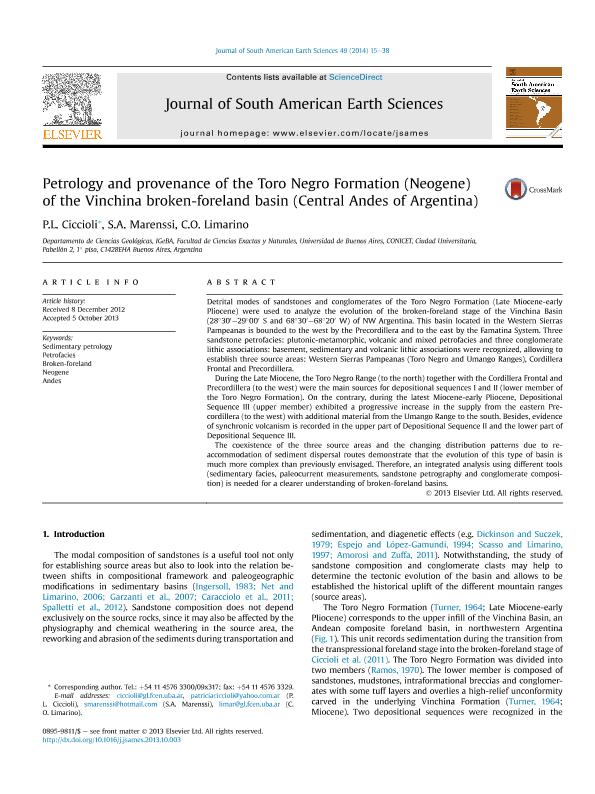Mostrar el registro sencillo del ítem
dc.contributor.author
Ciccioli, Patricia Lucia

dc.contributor.author
Marenssi, Sergio Alfredo

dc.contributor.author
Limarino, Carlos Oscar

dc.date.available
2017-12-13T18:07:37Z
dc.date.issued
2014-01
dc.identifier.citation
Ciccioli, Patricia Lucia; Marenssi, Sergio Alfredo; Limarino, Carlos Oscar; Petrology and provenance of the Toro Negro Formation (Neogene) of the Vinchina broken-foreland basin (Central Andes of Argentina); Elsevier; Journal of South American Earth Sciences; 49; 1-2014; 15-38
dc.identifier.issn
0895-9811
dc.identifier.uri
http://hdl.handle.net/11336/30481
dc.description.abstract
Detrital modes of sandstones and conglomerates of the Toro Negro Formation (Late Miocene-early Pliocene) were used to analyze the evolution of the broken-foreland stage of the Vinchina Basin (28°30′–29°00′ S and 68°30′–68°20′ W) of NW Argentina. This basin located in the Western Sierras Pampeanas is bounded to the west by the Precordillera and to the east by the Famatina System. Three sandstone petrofacies: plutonic-metamorphic, volcanic and mixed petrofacies and three conglomerate lithic associations: basement, sedimentary and volcanic lithic associations were recognized, allowing to establish three source areas: Western Sierras Pampeanas (Toro Negro and Umango Ranges), Cordillera Frontal and Precordillera. During the Late Miocene, the Toro Negro Range (to the north) together with the Cordillera Frontal and Precordillera (to the west) were the main sources for depositional sequences I and II (lower member of the Toro Negro Formation). On the contrary, during the latest Miocene-early Pliocene, Depositional Sequence III (upper member) exhibited a progressive increase in the supply from the eastern Precordillera (to the west) with additional material from the Umango Range to the south. Besides, evidence of synchronic volcanism is recorded in the upper part of Depositional Sequence II and the lower part of Depositional Sequence III. The coexistence of the three source areas and the changing distribution patterns due to re-accommodation of sediment dispersal routes demonstrate that the evolution of this type of basin is much more complex than previously envisaged. Therefore, an integrated analysis using different tools (sedimentary facies, paleocurrent measurements, sandstone petrography and conglomerate composition) is needed for a clearer understanding of broken-foreland basins.
dc.format
application/pdf
dc.language.iso
eng
dc.publisher
Elsevier

dc.rights
info:eu-repo/semantics/openAccess
dc.rights.uri
https://creativecommons.org/licenses/by-nc-nd/2.5/ar/
dc.subject
Sedimentary Petrology
dc.subject
Petrofacies
dc.subject
Broken-Foreland
dc.subject
Neogene
dc.subject
Andes
dc.subject.classification
Meteorología y Ciencias Atmosféricas

dc.subject.classification
Ciencias de la Tierra y relacionadas con el Medio Ambiente

dc.subject.classification
CIENCIAS NATURALES Y EXACTAS

dc.title
Petrology and provenance of the Toro Negro Formation (Neogene) of the Vinchina broken-foreland basin (Central Andes of Argentina)
dc.type
info:eu-repo/semantics/article
dc.type
info:ar-repo/semantics/artículo
dc.type
info:eu-repo/semantics/publishedVersion
dc.date.updated
2017-12-12T18:52:48Z
dc.journal.volume
49
dc.journal.pagination
15-38
dc.journal.pais
Países Bajos

dc.journal.ciudad
Amsterdam
dc.description.fil
Fil: Ciccioli, Patricia Lucia. Consejo Nacional de Investigaciones Científicas y Técnicas. Oficina de Coordinación Administrativa Ciudad Universitaria. Instituto de Geociencias Basicas, Aplicadas y Ambientales de Buenos Aires. Universidad de Buenos Aires. Facultad de Ciencias Exactas y Naturales. Instituto de Geociencias Basicas, Aplicadas y Ambientales de Buenos Aires; Argentina
dc.description.fil
Fil: Marenssi, Sergio Alfredo. Consejo Nacional de Investigaciones Científicas y Técnicas. Oficina de Coordinación Administrativa Ciudad Universitaria. Instituto de Geociencias Basicas, Aplicadas y Ambientales de Buenos Aires. Universidad de Buenos Aires. Facultad de Ciencias Exactas y Naturales. Instituto de Geociencias Basicas, Aplicadas y Ambientales de Buenos Aires; Argentina
dc.description.fil
Fil: Limarino, Carlos Oscar. Consejo Nacional de Investigaciones Científicas y Técnicas. Oficina de Coordinación Administrativa Ciudad Universitaria. Instituto de Geociencias Basicas, Aplicadas y Ambientales de Buenos Aires. Universidad de Buenos Aires. Facultad de Ciencias Exactas y Naturales. Instituto de Geociencias Basicas, Aplicadas y Ambientales de Buenos Aires; Argentina
dc.journal.title
Journal of South American Earth Sciences

dc.relation.alternativeid
info:eu-repo/semantics/altIdentifier/doi/http://dx.doi.org/10.1016/j.jsames.2013.10.003
dc.relation.alternativeid
info:eu-repo/semantics/altIdentifier/url/http://www.sciencedirect.com/science/article/pii/S0895981113001466
Archivos asociados
